Baodong Liu
LEARN++: Recurrent Dual-Domain Reconstruction Network for Compressed Sensing CT
Dec 13, 2020



Abstract:Compressed sensing (CS) computed tomography has been proven to be important for several clinical applications, such as sparse-view computed tomography (CT), digital tomosynthesis and interior tomography. Traditional compressed sensing focuses on the design of handcrafted prior regularizers, which are usually image-dependent and time-consuming. Inspired by recently proposed deep learning-based CT reconstruction models, we extend the state-of-the-art LEARN model to a dual-domain version, dubbed LEARN++. Different from existing iteration unrolling methods, which only involve projection data in the data consistency layer, the proposed LEARN++ model integrates two parallel and interactive subnetworks to perform image restoration and sinogram inpainting operations on both the image and projection domains simultaneously, which can fully explore the latent relations between projection data and reconstructed images. The experimental results demonstrate that the proposed LEARN++ model achieves competitive qualitative and quantitative results compared to several state-of-the-art methods in terms of both artifact reduction and detail preservation.
SmartTriage: A system for personalized patient data capture, documentation generation, and decision support
Oct 19, 2020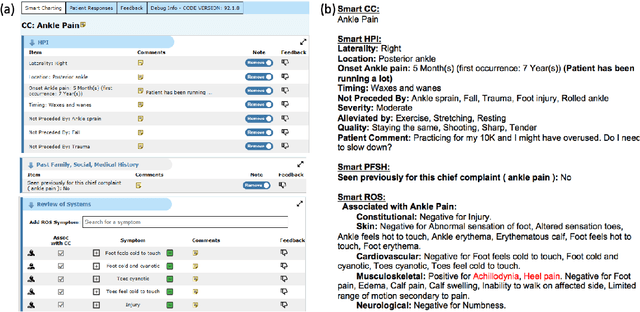
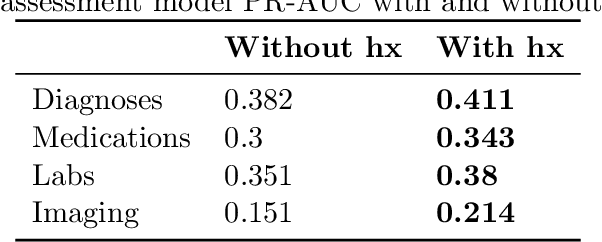
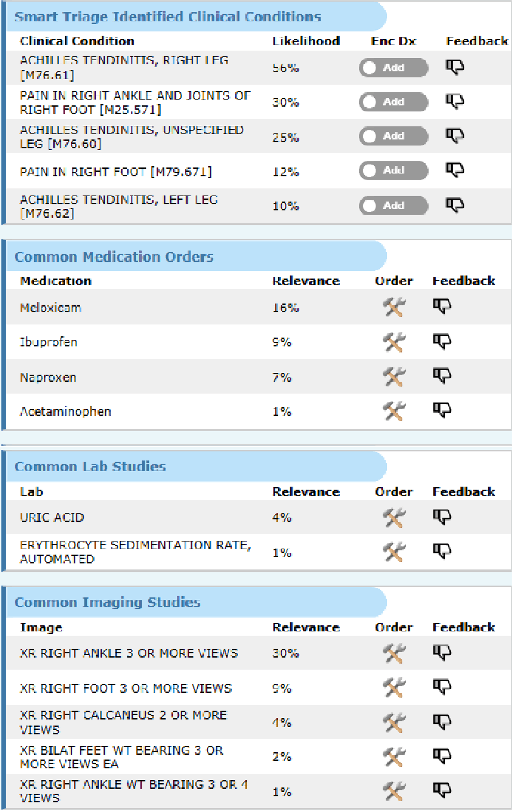
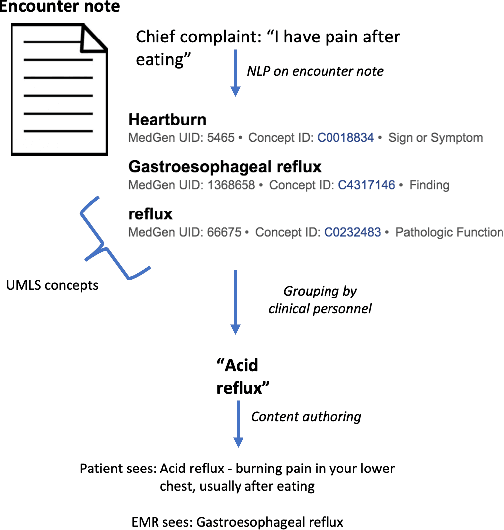
Abstract:Symptom checkers have emerged as an important tool for collecting symptoms and diagnosing patients, minimizing the involvement of clinical personnel. We developed a machine-learning-backed system, SmartTriage, which goes beyond conventional symptom checking through a tight bi-directional integration with the electronic medical record (EMR). Conditioned on EMR-derived patient history, our system identifies the patient's chief complaint from a free-text entry and then asks a series of discrete questions to obtain relevant symptomatology. The patient-specific data are used to predict detailed ICD-10-CM codes as well as medication, laboratory, and imaging orders. Patient responses and clinical decision support (CDS) predictions are then inserted back into the EMR. To train the machine learning components of SmartTriage, we employed novel data sets of over 25 million primary care encounters and 1 million patient free-text reason-for-visit entries. These data sets were used to construct: (1) a long short-term memory (LSTM) based patient history representation, (2) a fine-tuned transformer model for chief complaint extraction, (3) a random forest model for question sequencing, and (4) a feed-forward network for CDS predictions. We also present the full production architecture for the pilot deployment of SmartTriage that covers 337 patient chief complaints.
MetaInv-Net: Meta Inversion Network for Sparse View CT Image Reconstruction
May 30, 2020



Abstract:X-ray Computed Tomography (CT) is widely used in clinical applications such as diagnosis and image-guided interventions. In this paper, we propose a new deep learning based model for CT image reconstruction with the backbone network architecture built by unrolling an iterative algorithm. However, unlike the existing strategy to include as many data-adaptive components in the unrolled dynamics model as possible, we find that it is enough to only learn the parts where traditional designs mostly rely on intuitions and experience. More specifically, we propose to learn an initializer for the conjugate gradient (CG) algorithm that involved in one of the subproblems of the backbone model. Other components, such as image priors and hyperparameters, are kept as the original design. This makes the proposed model very light-weighted. Since a hypernetwork is introduced to inference on the initialization of the CG module, it makes the proposed model a certain meta-learning model. Therefore, we shall call the proposed model the meta-inversion network (MetaInv-Net). The proposed MetaInv-Net has much less trainable parameters and superior image reconstruction performance than some state-of-the-art deep models in CT imaging. In simulated and real data experiments, MetaInv-Net performs very well and can be generalized beyond the training setting, i.e., to other scanning settings, noise levels, and noise types.
JSR-Net: A Deep Network for Joint Spatial-Radon Domain CT Reconstruction from incomplete data
Dec 03, 2018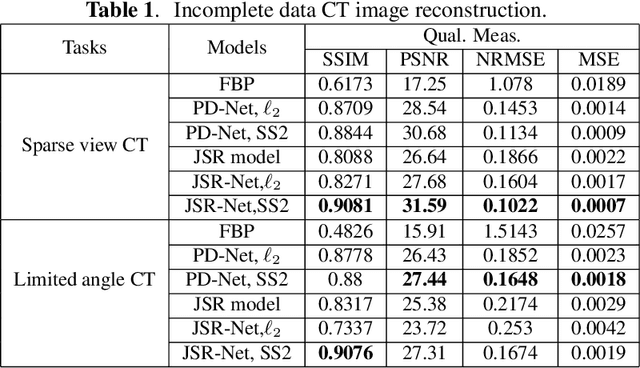
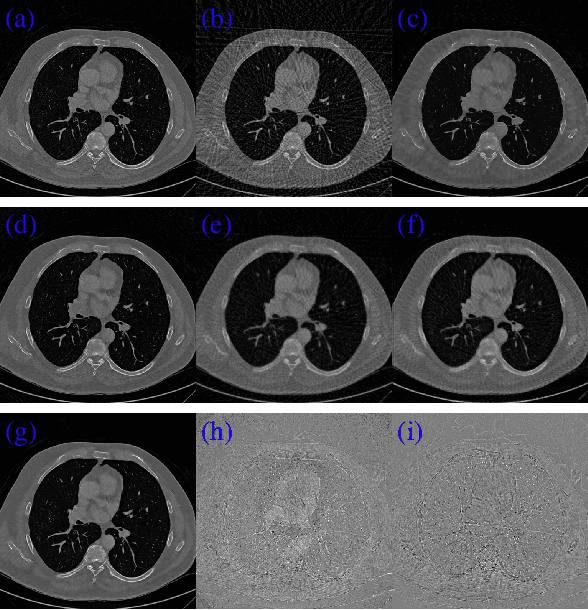
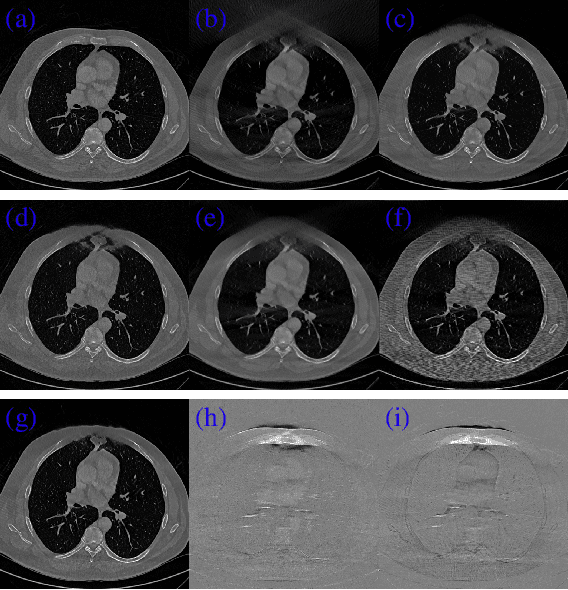
Abstract:CT image reconstruction from incomplete data, such as sparse views and limited angle reconstruction, is an important and challenging problem in medical imaging. This work proposes a new deep convolutional neural network (CNN), called JSR-Net, that jointly reconstructs CT images and their associated Radon domain projections. JSR-Net combines the traditional model based approach with deep architecture design of deep learning. A hybrid loss function is adopted to improve the performance of the JSR-Net making it more effective in protecting important image structures. Numerical experiments demonstrate that JSR-Net outperforms some latest model based reconstruction methods, as well as a recently proposed deep model.
Dictionary-Learning-Based Reconstruction Method for Electron Tomography
Nov 22, 2013
Abstract:Electron tomography usually suffers from so called missing wedge artifacts caused by limited tilt angle range. An equally sloped tomography (EST) acquisition scheme (which should be called the linogram sampling scheme) was recently applied to achieve 2.4-angstrom resolution. On the other hand, a compressive sensing-inspired reconstruction algorithm, known as adaptive dictionary based statistical iterative reconstruction (ADSIR), has been reported for x-ray computed tomography. In this paper, we evaluate the EST, ADSIR and an ordered-subset simultaneous algebraic reconstruction technique (OS-SART), and compare the ES and equally angled (EA) data acquisition modes. Our results show that OS-SART is comparable to EST, and the ADSIR outperforms EST and OS-SART. Furthermore, the equally sloped projection data acquisition mode has no advantage over the conventional equally angled mode in the context.
 Add to Chrome
Add to Chrome Add to Firefox
Add to Firefox Add to Edge
Add to Edge